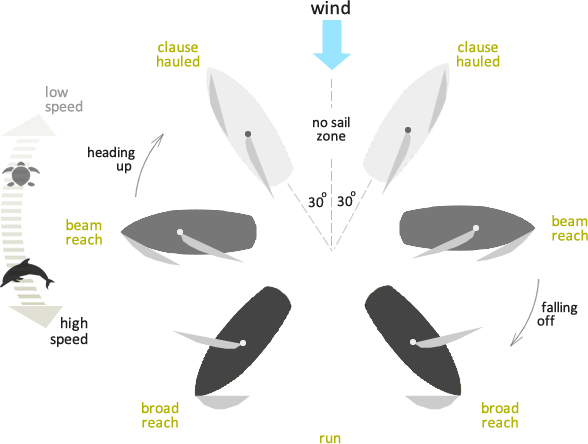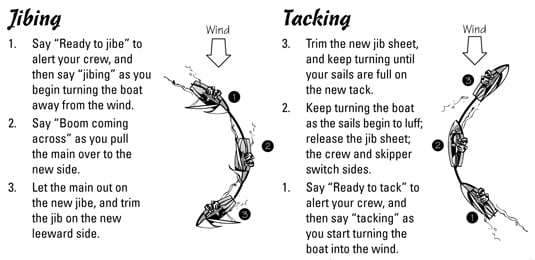
There is many parts name for a sailboat, here are some basic parts names of the sailboat essential for a sailor to know, its allow you to communicate and instructions with other crew
Backstay
Performs the same job as the Forestay but is attached to the stern of the boat as opposed to the bow
Boom
A horizontal spar attached to the aft of the mast just below the sail. The boom is attached to the sail and keeps the sail flatter when at an angle from the centerline of the boat
Bow
The front of the boat
Burgee
A flag identifying the recreational organisation of a boat
Forestay
Most commonly a stainless steel wire, the forestay is a piece of standing rigging which helps keep the mast upright. It is attached at the bow of the boat, to the top of the mast
Hull
Watertight body of the boat
Jib
Triangular sail at the foremast of the vessel
Keel
Generates lift using the forward motion of the boat, counteracting the leeward force of the wind. It also provides ballast to the boat
Kicking Strap
A line that connects the boom to the lower of the mast to provide down force on the boom
Main Sail
Sail located behind the main mast of the vessel
Mast
A tall vertical spar that supports the sails
Rudder
Used to steer the boat through the water
Stern
The back of the boat
Topping Lift
A line used to hold the boom up while the sail is lowered.
Most commonly attached to the aft of the boom to the top of the mast. It is
loosened or removed once the sail is raised

A sailboat cannot sail directly into the wind. But it can sail to within about 45 degrees of the wind direction on either side. Thus one can tack back and forth (in a zigzag pattern) to travel in the direction from which the wind is coming.
Although the boat cannot sail directly into the gray zone it can travel in all other directions. To go in the direction of the wind one sails as close to the wind as possible (close hauled, also known as beating) for awhile, then tacks (turns across the wind) to the other side and continues in that direction for awhile. This process is repeated until one reaches ones
Sailing Term
Aft - The back of a ship. If something is located
aft, it is at the back of the sailboat. The aft is also known as the
stern.
Port - Port is always the left-hand side of the boat when you are facing
the bow. Because “right” and “left” can become confusing sailing terms when
used out in the open waters, port is used to define the left-hand side of the
boat as it relates to the bow, or front.
Starboard - Starboard is always the right-hand side of the boat when you
are facing the bow. Because “right” and “left” can become confusing sailing
terms when used out in the open waters, starboard is used to define the
right-hand side of the boat as it relates to the bow, or front.
Leeward - Also known as lee, leeward is the direction opposite to the
way the wind is currently blowing (windward).
Windward - The direction in which the wind is currently blowing.
Windward is the opposite of leeward (the opposite direction of the wind).
Sailboats tend to move with the wind, making the windward direction an
important sailing term to know.
Tacking - The opposite of jibing, this basic sailing maneuver refers to
turning the bow of the boat through the wind so that the wind changes from one
side of the boat to the other side. The boom of a boat will always shift from
one side to the other when performing a tack or a jibe.
Jibing - The opposite of tacking, this basic sailing maneuver refers to turning the stern of the boat through the wind so that the wind changes from one side of the boat to the other side. The boom of a boat will always shift from one side to the other when performing a tack or a jibe. Jibing is a less common technique than tacking, since it involves turning a boat directly into the wind.

What is the different between Jibe and Tack
The Tack
When a sailboat tacks it is moving from a starboard tack to a port tack or, alternatively, a port tack to starboard tack. This means you are turning through the wind - in the case of a tack you are turning the bow of the boat (the front) through the wind.
The Jibe (Gybe)
Like a tack, the gybe takes place when you turn a boat through the wind and take it from one tack (say port) to another (say starboard) - or vice versa. The difference is that in the case of a gybe (as opposed to a tack) we have turned the stern (back) of the boat through the wind.
Jibe or Gybe
A jibe (US) or gybe (Britain) is a sailing maneuver whereby a sailing vessel reaching downwind turns its stern through the wind, which then exerts its force from the opposite side of the vessel. ... Tacking more than 180° to avoid a jibe is sometimes referred to as a 'chicken jibe'.
Why is it important to know the difference?
First of all, we need to know these definitions so that crew know what they are about to do. “Standby to tack” or “ready about” are instructions given by the helm and both terms notify the crew that they will be tacking. “Standby to gybe” or “ready to gybe” would indicate… a gybe. Yep - it isn’t rocket science.
A tack is generally much less involved than a gybe. The primary reason for this is that, when cruising at least, the tack requires the mainsheet trimmer to do very little, if anything’ when tacking through the wind (assuming you are tacking from close hauled to close hauled).
The gybe is different because of the way the mainsail is rigged. The leading edge of the mainsail is called the luff. This is attached to the mast by way of sliders that run up and down the mast in a track. The back edge (the leach) is not fixed. This means that in a tack the sail simply depowers, flaps a little and then powers-up again.
In a gybe the mainsail (which is let out perpendicular to the wind direction) must be centred by the mainsheet trimmer BEFORE the gybe. Failure to do so will result in the mainsail whipping across the boat in what is generally referred to as a ‘crash gybe’ or ‘accidental gybe’. The crash gybe is very dangerous. The risk of being hit by the book or collected by the mainsheet is very real and it can be lethal.
Understanding Running Rigging
Sailling terms can be tricky. There are many type of rope and name to distinguish the function. Sailor use the word "Sheet" to refer to lines that control the sail and "Halyard" is the line to raise or lower a sail.
Sheets are responsible for adjusting or trimming the sails. They are named after the sail they control such as mainsheet or jib sheet. The mainsheet is a line attached to the boom used to adjust the sail angle to the wind and control the boat speed. The Jibsheet are two ropes which lead from clew of a jib to bothside of port and starboard and by which to sail the trimmed.
Type of sails
There is many type of sail on sailboat, the mainsail, jibsail (headsail), genoa, spinnnaker. Different sail serve different purpose, it is important to know which sail to choose since the sail is kind like the "engine of the sailboat.
Mainsail are found behind the mast and attach to the boom, its have a large surface area with respect to the incoming winds. All point of sail are achievable to provide a good forward propulsion, they don't required strong wind as they have a large surface to cover.
Jibsail or (Headsail) is the second type of sail which accompanies the mainsail on a sailboats. It is smaller surface than mainsail and placed at the front of the mast which cover the bow of the sailboat.
Genoa is a type of large jib which attach to the front of the forestay, sometrimes its extends behind the mast and partially covering the mainsail. he surface area are large and it is important to use when winds are low and wind is coming directly from the rear.
Spinnakers are special sails made for the specific purpose of sailing
off the wind from a reaching course to a downwind, with the wind 90ᵒ to
180ᵒ off the bow. The sails fill with wind then flare out and in front
of the boat, which is often called flying. Spinnaker sails are usually
made of a very lightweight fabric, including nylon, and they are often
purchased in bright, eye-catching colors. Spinnaker sails are very large
and aren’t very accommodating when you’re experiencing rough waters


No comments:
Post a Comment